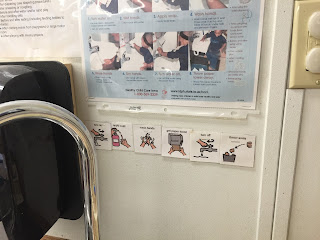About 4 years ago the preschools in my school district
started using a free pre-reading curriculum entitled Read it Again. Laura M. Justice and Anita S. McGinty created
it as part of their work at The Ohio State University. The curriculum is great because it uses
common books that preschool teachers use in the classroom already. Each lesson also
has adaptations for students who need a little bit more from the lessons and
for students who need a little more help from the lessons. I have gotten used to the lessons and find
them very useful in introducing pre-reading skills.
My classroom serves nonverbal students with a functioning
level of 12 months to 3/4 years of age.
So, I have adapted the lessons even farther to include a vocabulary
element and visuals each time I teach the lessons. I have done this by adapting the book pages
with pictures of vocabulary words from the story line. The students need to find the pictures From a
group of pictures and then match the pictures to ones on the page. See a picture below of what this looks like
for the book Rumble in the Jungle By: Giles Andreae and David Wojtowycz:
I also use visuals to help with story retelling and
comprehensions with some visuals created by Speech Language Pathologist for the
Read it Again lessons. The visuals help them answer the questions about the
book and help them to retell as well.
They have been very useful to help gain comprehension skills. Some students can use them independently and
some need adult assistance. Either way
they are a good introduction to comprehension skills. You can see a picture of
what these look for the book Rumble in the Jungle below:
You can download the entire curriculum for free at:
http://ccec.ehe.osu.edu/practice/ccec-curricula/read-it-again-pre-k/materials/







